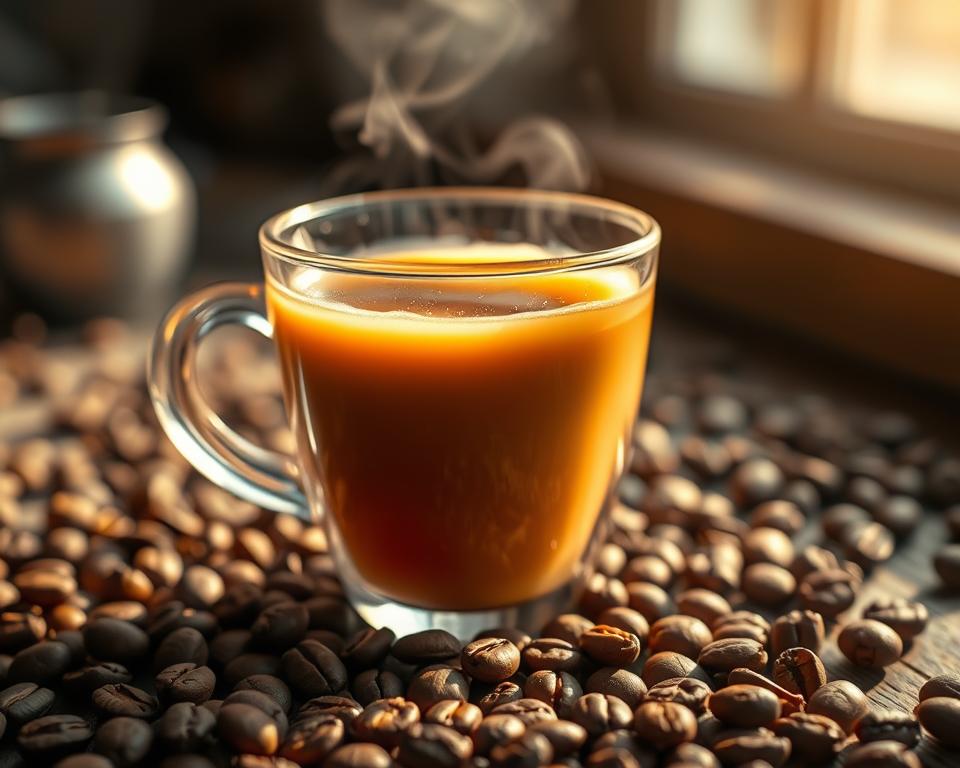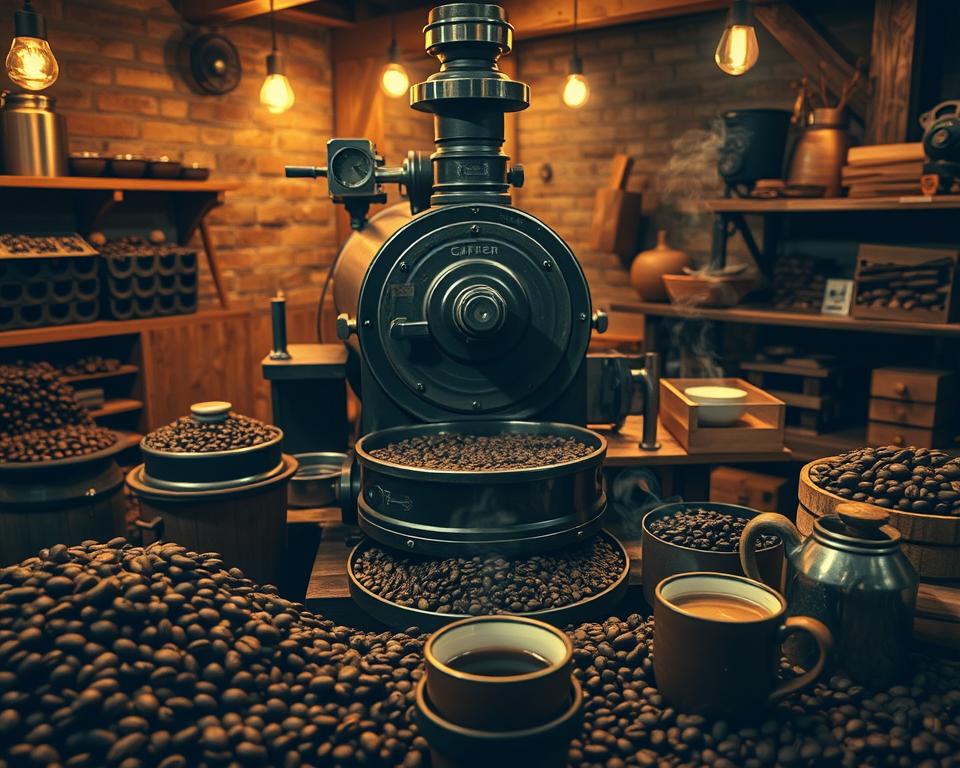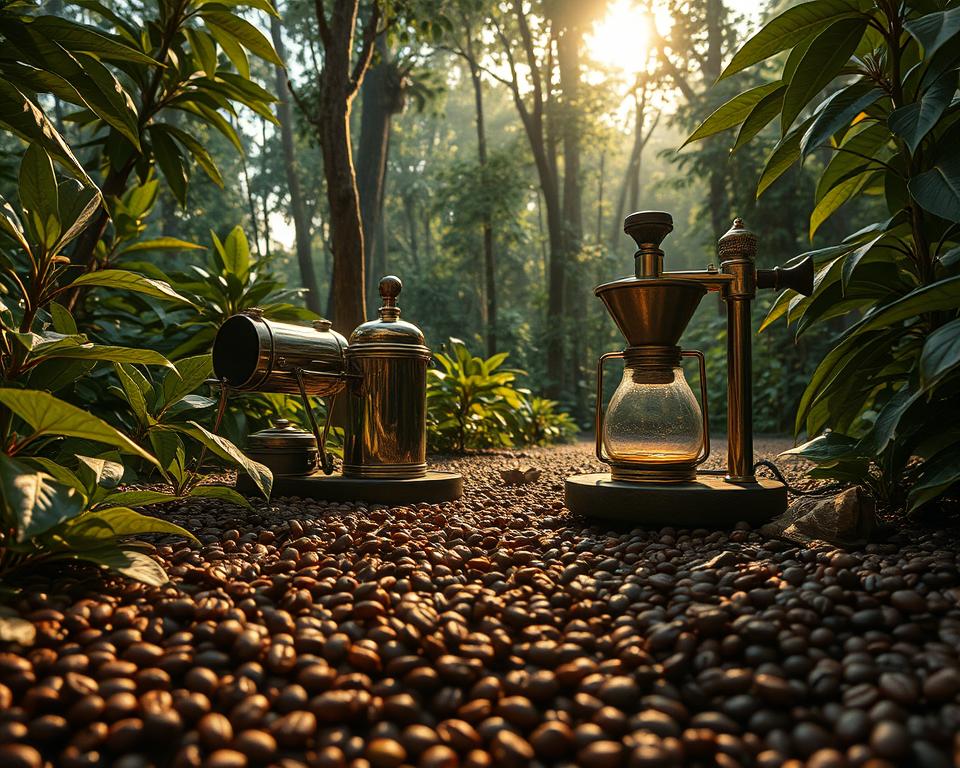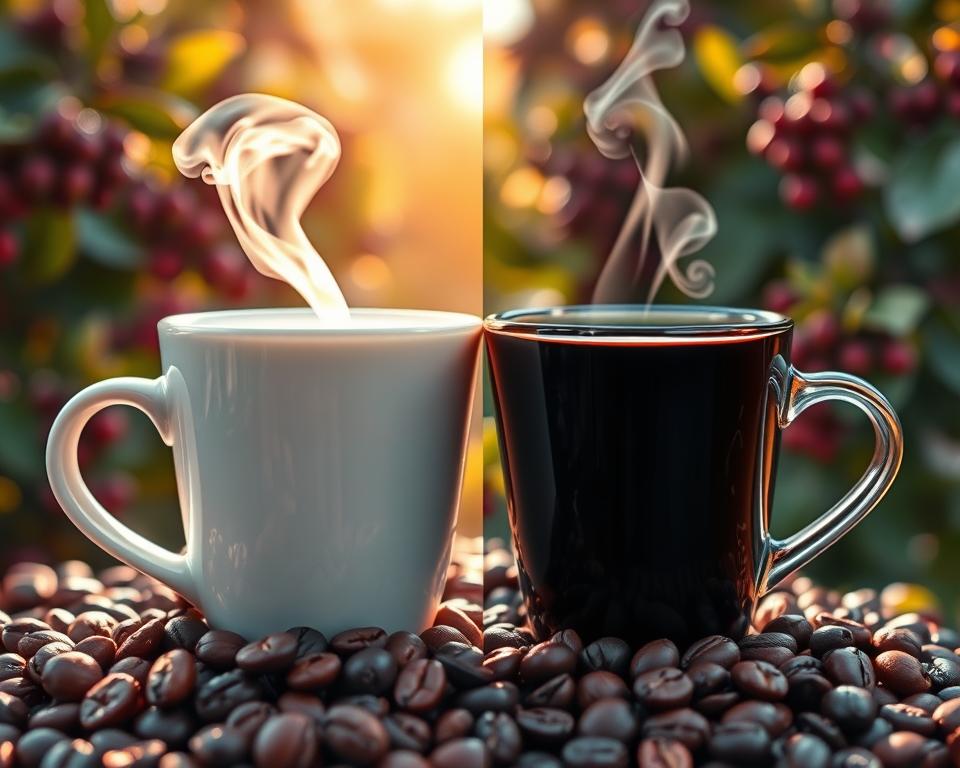If you love coffee, specialty light roast beans are perfect. They offer bright acidity and juicy notes. Their vibrant, sweet profiles and balanced flavors make every sip delightful.
These beans get their special taste from a shorter, cooler roasting process. It brings out the coffee’s natural qualities. Beans from places like Ethiopia and Colombia are great for this. They make a brew that’s light and not too bitter, letting you taste where they’re from.
Specialty coffee roasters take great care in making these light roasts. They aim for coffee that’s bright, flavorful, and smooth. It’s a taste journey in every cup.
Light roast coffee also stands out for being fruity and complex. It keeps more moisture, which means more flavor. You might notice hints of citrus or berries. Plus, light roast coffee has health perks. Learn more about them here.
What Are Specialty Light Roast Beans?
Specialty light roast beans highlight the coffee’s own flavors. Roasting stops right after the first crack. This keeps their natural tastes, making the coffee bright and complex.

The Roasting Process
Roasting light roast coffee is an art. It keeps the beans’ moisture by stopping the roast at lower temperatures. This captures a range of flavors, from fruits to flowers. The beans look dry and wrinkly without any oil on the surface.
Origins and History
Light roast coffee has a rich history. It gained popularity in specialty coffee shops in the Western U.S. during the 1960s and 1970s. These shops highlighted the beans’ unique features.
High-grown Arabica beans from places like Ethiopia and Colombia are perfect for light roasts. Their vibrant acidity and complex flavors are preserved. This method honors coffee’s diverse origins and careful processing.
Flavor Profile of Specialty Light Roast Beans
Learning about specialty light roast beans can make your coffee experience better. These beans are known for their light roast. This keeps all the flavors and qualities of the coffee bean. Coffees from places like Ethiopia, Kenya, Colombia, and Costa Rica are preferred for this.
Fruity and Floral Notes
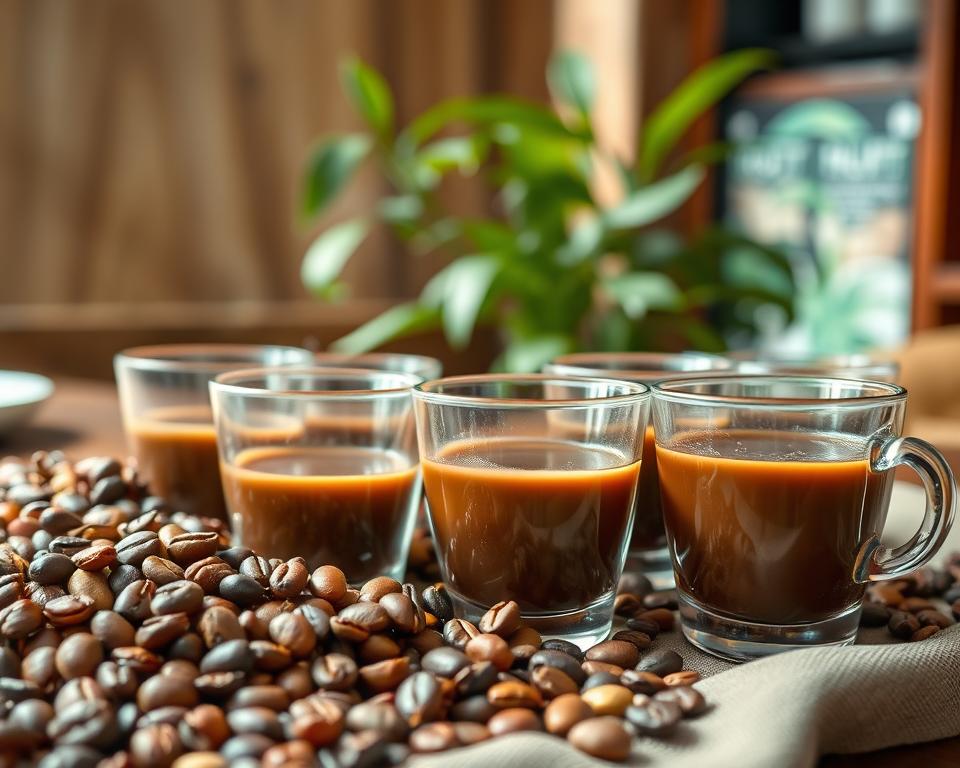
When tasting coffee, finding fruity and floral aromas is exciting. Specialty light roasts can remind you of fresh fruits and flowers. Think of lavender, jasmine, and honeysuckle. Ethiopian coffees, which are often lightly roasted, are full of bright, fruity tastes. They can vary from zesty citrus flavors to wild berries, making your coffee refreshing and aromatic.
Acidity and Body
Light roast coffees are lively, thanks to their acidity. You might describe them as zesty, tangy, crisp, or vibrant. Different acids in the coffee bring out a range of flavors, from sweet citrus to a bit of sourness. This mix enhances the taste, making it complex.
These coffees have a light body, feeling more like tea in your mouth. This lets you taste the subtler flavors clearly. Because these beans are lightly roasted, there is minimal caramelization. This preserves the natural sugars and helps maintain a good balance between acidity and bitterness.
Light roast coffees look dry and wrinkled, are smaller, and don’t have oil on the surface. This special look means the coffee keeps its original qualities and acidity. This creates an amazing coffee experience that brings out the brightness and delicacy in every cup.
Caffeine Content and Health Benefits
Light roast coffee stands out because it has slightly more caffeine than dark roasts. This is due to the shorter roasting time. More caffeine stays in the coffee, making it more energizing. On average, light roast coffee has about 95 milligrams of caffeine per 8-ounce serving.
Caffeine Levels
It’s important to know how much caffeine is in coffee. The FDA says adults can safely have up to 400 milligrams a day. That’s about 4-5 cups of coffee. Arabica beans, often used in light roasts, have 0.9 to 1.5% caffeine after drying. Robusta beans have more, with 1.2 to 2.4%.
The way you brew coffee also changes its caffeine amount. Finely ground coffee releases more caffeine. An 8-ounce cup of drip coffee usually has about 95 milligrams of caffeine.
Health Benefits
Coffee is full of health perks. It has a lot of antioxidants, like chlorogenic acid. These help reduce inflammation and may lower the risk of diseases such as heart disease and diabetes. Plus, coffee can make your gut microbiome more diverse, improving gut health.
Regular coffee drinkers tend to exercise more, studies show. Even decaf coffee is good for you, because it has similar beneficial compounds. But, the health effects of trendy coffees like bulletproof or turmeric coffee aren’t well-studied yet.
Drinking your morning light roast coffee is good for both a caffeine boost and health benefits. Coffee is an important part of many people’s daily lives.
How Do Artisan Coffee Roasting Techniques Enhance the Flavor of Specialty Light Roast Beans?
Artisan coffee roasting techniques play a crucial role in enhancing the flavor profiles of specialty light roast beans. By utilizing artisan methods for coffee roasting, roasters can carefully control temperature and time, unlocking unique taste notes while maintaining the beans’ natural brightness and acidity. This precision results in a richer, more nuanced cup.
Brewing Methods for Maximum Flavor
Choosing the right way to brew can make a big difference. Especially with specialty light roast beans, it matters a lot. The best methods bring out fruity and floral flavors. They make the coffee special. We’ll look into pour-over and drip coffee methods closely.
Pour Over
Pour-over brewing is perfect for specialty light roast coffee. It lets you control every step of brewing. This ensures every cup is just right. The careful pour of water makes sure flavors come out evenly. Use a medium-fine grind and keep the water between 195°F to 205°F. High-quality water also matters. Aim for alkalinity between 30-50 ppm and hardness between 30-100 ppm.
Drip and Filter Coffee
Drip and filter coffee methods work well for light roast beans too. They deliver a balanced and lively cup. Aiming for a medium grind and a TDS of 1.3%—1.4% is key. With these methods, how you grind and the water temperature you use are crucial. Keep the water temperature between 195°F to 205°F. This avoids bitterness and brings out a great flavor.
Using these methods correctly unlocks the best in light roast beans. They ensure your coffee is bright and full of flavor. Both pour-over and drip coffee let you enjoy all the subtle tastes. Getting good at these methods takes practice and attention to detail. But, it’s worth it for the amazing coffee you’ll make.
FAQ
What makes specialty light roast beans distinct in the coffee world?
Specialty light roast beans stand out with their lively, sweet profiles. They roast for a shorter time, stopping just after the first crack appears. This process brings out the bean’s true character, offering bright acidity and detailed flavors.
Which regions produce the best beans for light roasting?
Regions like Ethiopia, Kenya, Colombia, and Costa Rica are known for their high-quality Arabica beans. These areas excel in beans that reveal fruity and floral tastes. They have little bitterness and a delicate body.
How did light roast coffee gain popularity in the United States?
Light roast coffee got popular in the 60s and 70s, especially on the West Coast. Coffee shops began to showcase light roasts’ unique characteristics. They highlight the coffee’s origin and how it’s processed.
What flavors can I expect from specialty light roast beans?
Expect to taste notes of citrus, cherries, wild berries, jasmine, and other aromatic flowers in specialty light roast beans. These flavors are vivid and make the coffee tasting experience complex and enjoyable.
Is light roast coffee more acidic than other roasts?
Light roast coffee is indeed bright and has a lively acidity. However, this does not make it more acidic in pH. The acidity adds to the coffee’s complexity without increasing its actual acidity.
How does the caffeine content in light roast coffee compare to darker roasts?
Light roast coffee usually has more caffeine than darker roasts. This is because it’s roasted for less time. As a result, light roasts might be more energizing, with more caffeine per serving.
Are there any health benefits to drinking light roast coffee?
Yes, drinking light roast coffee can be good for your health. It’s packed with antioxidants like chlorogenic acid. These antioxidants have anti-inflammatory effects and can help lower the risk of chronic diseases.
What brewing methods are best for specialty light roast beans?
The pour-over method is ideal for specialty light roast beans. It brings out their delicate tastes. Drip and filter brewing methods are great too. They extract the flavors fully without hiding the bean’s natural notes.
What grind size and water temperature are ideal for light roast coffee?
For light roast coffee, a medium-fine grind and water between 195°F to 205°F are perfect. This ensures the best flavor extraction. It showcases the coffee’s bright acidity and complex taste profile.
Why do specialty coffee roasters focus on light roast coffee?
Specialty roasters focus on light roast coffee to preserve the beans’ inherent qualities. A short roast keeps the flavor complexity, from acidity to natural sugars. This creates a coffee that takes you on a sensory journey with each sip.

